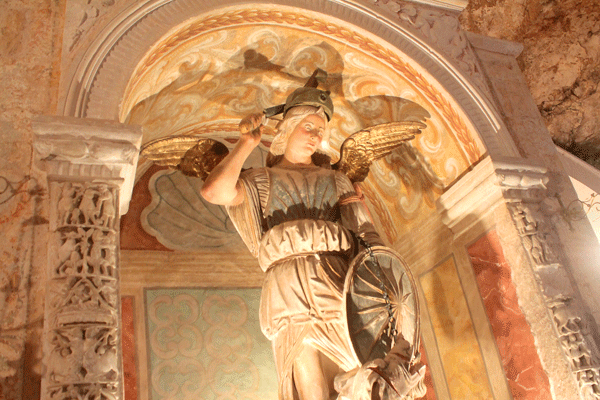
The first years of the 16th century the Fathers of the Carmelite order took turns in the underground church, who contributed to modify its overall structure and to increase the works of art present.
During the first decades of the 1500s the cave was radically transformed by adding to the central part, then the main altar and the Angevin chapel, two other niches placed sideways to it, namely the one on the left, where the statue of San Michele is kept. dominates and defeats the dragon, the work of the great sculptor Stefano da Putignano (as evidenced by the signature at the bottom of the sculpture itself) and the niche on the right, where the Madonna del Carmine is represented between Sant'Angelo Martire and Sant'Alberto work attributed to the Putignanese painter
Francesco Palvisino (attribution not 100% proven). It is thought that this last niche may have housed, before the wall painting, the statue of San Sebastiano subsequently moved to the
Cappella di San Cesario e dei santi protettori minori of the church of San Pietro Apostolo.
The Carmelite fathers also had other niches created in the middle of the stairway leading to the cave, and specifically the one containing a statue of the Virgin and Child who is preparing to be crowned by two angels descending from heaven, the work of students of Stephen's workshop. from Putignano.
Moving two centuries forward in the mid-18th century there are further embellishments. One of these is the altar and the stone balustrade placed under the niche where the statue of San Michele is placed.
In the nineteenth century the ownership of the site passed into the hands of the Romanazzi Carducci family and then during the Fascist period, the whole area passed into the hands of the Provincial Antitubercular Consortium.


 This website project born from the idea of Gianni Musaio is enclosed in a team spirit and is the result of the collaboration of people, ordinary citizens, who care about the historical, cultural, artistic, geographical, food and wine heritage of the historic center of Putignano, a town in to live.
This website project born from the idea of Gianni Musaio is enclosed in a team spirit and is the result of the collaboration of people, ordinary citizens, who care about the historical, cultural, artistic, geographical, food and wine heritage of the historic center of Putignano, a town in to live.